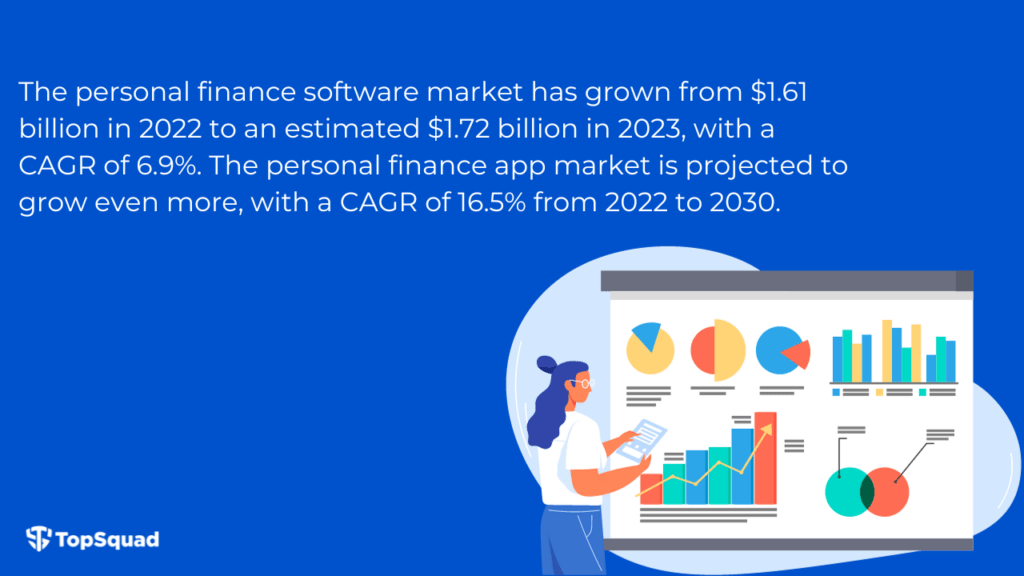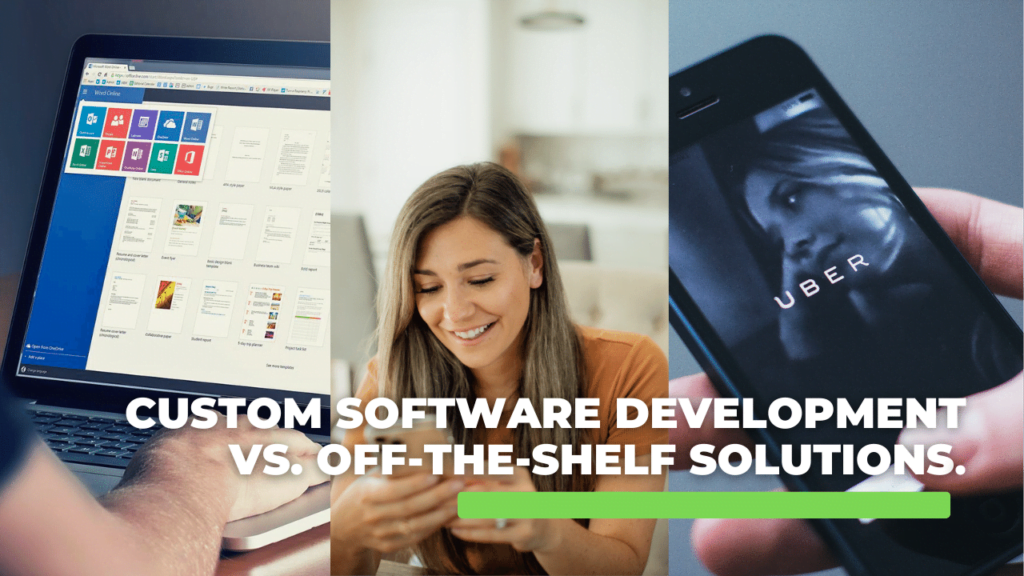What is a Personal Finance App?
In the fast-paced digital age, effective personal finance management is increasingly vital. The growing demand for financial autonomy has made personal finance apps key for savvy budgeting and investment.
Driven by a shift towards digital financial tools, these apps are changing the way we handle money. In this article, we will cover the essentials of personal finance app, their role in today’s financial landscape, and their impact on budgeting and financial decisions. We’ll explore various app types and the process of creating one, offering a complete overview of this evolving market.
1.1 Market Overview:
In delving into the market overview of personal finance apps, it’s important to recognize the substantial growth and evolution of this sector in recent years.
Personal finance software market grew from $1.61 billion in 2022 to $1.72 billion in 2023, a 6.9% CAGR. India led in 2022 with 149 crore finance app downloads, showing global adoption.
Furthermore, the personal finance app market, in particular, is forecasted to grow at an even more impressive CAGR of 16.5% from 2022 to 2030.
This remarkable expansion is driven by factors like the increasing adoption of smartphones and tablets, coupled with a growing demand for mobile banking and financial services. This trend not only highlights the apps’ popularity but also underscores their pivotal role in the modern financial ecosystem. With Advanced AI and machine learning make finance apps more intuitive and personalized.

1.2 Role of a Personal Finance App:
The role of a personal finance app in today’s digital age extends far beyond basic budgeting. They are comprehensive platforms for financial management. These apps provide real-time insights, simplifying financial planning for a wider audience. They offer functionalities like expense tracking, investment monitoring, and financial goal planning, consolidating all financial data in one place for a complete view of one’s finances. Features such as bill reminders, savings goals, and credit score monitoring enhance their utility. Evolving from basic budget trackers, these apps have become essential in making financial management accessible and understandable, serving as key tools in navigating the complexities of today’s financial landscape.
Here’s a deeper look into their diverse capabilities:
- Budgeting and Expense Tracking: Personal finance apps enable users to input their daily expenses and compare them against predefined budgets. This feature not only helps in tracking where the money goes but also in identifying spending patterns. Users can set monthly or weekly budget limits for different categories like groceries, entertainment, and utilities, making it easier to control overspending.
- Investment Monitoring: For those engaged in investments, these apps provide a convenient way to monitor stock market trends, track the performance of individual investments, and even receive personalized advice based on their investment profile.
- Debt Management and Reduction: Users with loans or credit card debts can benefit from features that help track their debts, plan repayment schedules, and even negotiate better repayment terms.
- Savings and Financial Goal Planning: Personal finance apps often include tools for setting and tracking savings goals. Whether it’s saving for a vacation, a new car, or an emergency fund, these apps can help users allocate funds regularly towards these goals.
- Credit Score Monitoring: With credit scores playing a crucial role in financial health, many personal finance apps now offer credit monitoring services. They provide insights into factors affecting credit scores and tips for improvement.
- Bill Management: The ability to track and manage bills, including setting up reminders for due dates, is another vital feature. This ensures that users avoid late payments and maintain a healthy financial record.
- Financial Insights and Reports: Advanced analytics in these apps can offer personalized financial insights and reports. This help users understand their financial health better and make informed decisions.
- Security: As these apps deal with sensitive financial information, they often employ robust security measures like encryption, two-factor authentication, and regular security audits to protect user data.
Personal finance apps offer a user-centric design and modern technology that act as a dashboard blending traditional finance management. It provide a macro and micro-level view of one’s financial status, and empowering users to take control of their finances.
Types of Personal Finance App
Personal finance apps come in various types, each tailored to meet specific financial needs and preferences. Understanding these categories is essential for users to choose the right app for their unique financial situation. Here’s a breakdown of the most common types:
- Budget Trackers and Expense Managers: These apps focus on daily expense tracking and budgeting. Users can record their purchases and categorize them to see where their money is going. They often provide visual representations like charts and graphs to help users understand their spending habits better.
- Investment Tracking Apps: Aimed at investors, these apps provide tools for tracking the performance of stocks, bonds, mutual funds, and other investments. They offer real-time market data, portfolio analysis, and sometimes even robo-advisor services for automated investment advice.
- Debt Reduction and Management Apps: These are designed for users with debts, such as student loans or credit card balances. They help in creating repayment plans, tracking progress towards debt freedom, and sometimes negotiating with creditors.
- Savings and Goal-Oriented Apps: Focused on long-term financial goals, these apps allow users to set specific targets, like saving for a vacation or a down payment on a house, and track their progress. They may also offer features to automate savings.
- Wealth Management Apps: For users with significant investments and assets, these apps offer comprehensive tools for wealth management, including investment advice, tax planning, and retirement planning.
- Financial Health and Credit Score Apps: These apps provide insights into a user’s overall financial health, including credit score monitoring, tips for improving credit, and alerts for any changes in credit status.
- Tax Preparation and Management Apps: Designed to simplify the tax preparation process, these apps assist with tracking deductible expenses, organizing financial documents, and even filing taxes directly from the app.
By integrating these key features, a personal finance app can provide financial management tools that cater to a wide range of user needs, making it an indispensable tool for personal finance management.
How to Create a Personal Finance App
Creating a personal finance app is a multifaceted process, requiring meticulous planning and execution. For IT professionals and developers, here’s an expanded guide to each step in the development journey:
Step 1: In-Depth Market Research and Target Audience Analysis
Begin by conducting comprehensive market research. This involves analyzing current market trends, understanding the competitive landscape, and identifying the unique needs and behaviors of your target audience. Utilize surveys, focus groups, and market analysis reports to gather valuable insights. This foundational step is crucial for tailoring your app’s features and functionalities to meet specific market demands and user expectations.
Step 2: Detailed Feature Set Definition and Planning
With insights from your research, meticulously define the app’s feature set. Include essential features like budgeting, tracking, and goal-setting, plus innovative ones like predictive analytics and digital banking integration, to enhance user experience.
Step 3: Selecting a Robust Technology Stack
Choosing the right technology stack is critical. For front-end development, decide on frameworks and languages that ensure a responsive and intuitive user interface, such as React or Swift for mobile apps. For the back-end, technologies like Node.js or Python, coupled with secure and scalable databases, are essential. The choice of APIs for bank synchronization or financial data aggregation must prioritize security and reliability.
Step 4: Advanced UI/UX Design Considerations
The user interface (UI) and user experience (UX) design are pivotal. The UI must be visually appealing yet functional, with a clear layout and easy navigation. The UX should focus on a seamless and engaging user journey. features like personalized dashboards, easy onboarding, and interactive financial insights. Conduct user testing with prototypes to refine the design based on real user feedback.
Step 5: Comprehensive Development and Rigorous Testing
During the development phase, employ agile methodologies to allow flexibility and continuous improvement. Incorporate best coding practices and focus on building a secure, efficient, and scalable app. Rigorous testing, including functional, performance, and security testing, is vital to ensure the app’s reliability and safety. Employ automated testing tools and conduct beta testing with real users to uncover any potential issues.
Step 6: Ensuring Security and Regulatory Compliance
Implement state-of-the-art security measures to protect sensitive financial data. This includes secure data encryption, robust user authentication methods, and regular security audits. Ensure the app complies with relevant financial regulations and data protection laws, like GDPR or PCI DSS, to build trust and avoid legal issues.
Step 7: Strategic Launch and Continuous Improvement Plan
Launching the app is just the beginning. Develop a marketing strategy to effectively reach your target audience. After the launch, actively seek user feedback and monitor app analytics to understand user behavior. Regular updates based on user feedback and emerging technologies are crucial for keeping the app relevant and ahead of competitors.
Creating a personal finance app requires technical skill, financial knowledge, and user focus. IT firms can exceed consumer expectations, offering a robust financial management tool.

Key Features to Include in Your Personal App
When developing a personal finance app, incorporating the right features is crucial for its success and user satisfaction. Each feature should add tangible value to the user’s financial management experience. Here are essential features to consider:
- Real-time Budget Tracking and Analysis: Implement a feature that allows users to input or automatically import their expenses and incomes. The app should categorize these transactions and provide real-time analysis of spending against predefined budgets. Include visual tools like graphs or pie charts for an easy understanding of spending patterns.
- Secure Account Synchronization: Offer the ability to securely connect users’ bank accounts, credit cards, and investment accounts. This synchronization should provide an up-to-date overview of the user’s financial status, including balances, transactions, and investment performance.
- Customizable Financial Goals and Savings Plans: Enable users to set and track financial goals, such as saving for a holiday, buying a home, or creating an emergency fund. Offer tools to create customizable savings plans, including automated transfers to savings accounts.
- Debt Management Tools: Integrate features for managing and tracking debts, such as credit cards, student loans, or mortgages. Provide options for users to set repayment goals and strategies, and visualize their progress towards becoming debt-free.
- Investment Tracking and Management: For users engaged in investments, include functionalities to track the performance of stocks, mutual funds, and other securities. Offer insights and analytics on investment performance and market trends.
- Bill Payment Reminders and Scheduling: Implement a system to track and remind users of upcoming bills and due dates. Offer functionality to schedule payments directly through the app, ensuring timely payments and avoiding late fees.
- Financial Reports and Insights: Provide detailed financial reports and insights, offering users a comprehensive view of their financial health. These reports can include income and expense breakdowns, financial trends over time, and personalized tips for financial improvement.
- Robust Security Measures: Given the sensitive nature of financial data, incorporate robust security features, including data encryption, multi-factor authentication, and regular security audits. Ensure user data is protected with the highest standards of security.
- User-friendly Interface and Accessibility: Design an intuitive and easy-to-navigate user interface. Ensure the app is accessible, with features like voice commands or screen readers for users with disabilities.
- Notifications and Alerts: Include customizable notifications and alerts for important financial updates, such as unusual spending, reaching a savings goal, or important investment changes.
- Tax Management Tools: Consider incorporating features to assist with tax management, such as tracking deductible expenses, estimating taxes, and integrating with tax filing services.
By integrating these key features, a personal finance app can provide financial management tools that cater to a wide range of user needs, making it an indispensable tool for personal finance management.
Conclusion
In conclusion, personal finance apps are a vital and dynamic part of modern financial management. Their increasing popularity highlights the need for accessible and comprehensive tools for managing finances. These apps, offering everything from budget tracking to investment monitoring, have transformed how we handle personal finance. For IT companies and developers, creating these apps presents a chance to innovate and shape the future of financial management. By aligning with market needs and prioritizing user-focused design and security, developers can build apps that evolve with emerging trends and technologies like AI. The growth potential in this sector is vast, significantly impacting users’ financial literacy and independence.
The key takeaway for anyone looking to develop or use a personal finance app is to focus on the intersection of technology and user needs. It’s about creating a tool that not only manages finances but also educates and empowers users. It help them make informed financial decisions for a more secure and prosperous future.
Work with Us!
TopSquad offers a comprehensive technology services that caters to the specific needs of businesses. With our expertise in the tech industry and a deep understanding of the skills required for programming roles, we assist companies in sourcing and attracting top-notch programming talent. Our service encompasses everything from crafting compelling job descriptions to conducting rigorous screening processes.
By partnering with TopSquad, businesses can streamline their hiring process and gain access to the best programmers in the industry, ultimately bolstering their teams and driving success.













